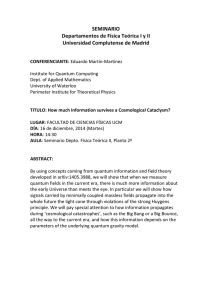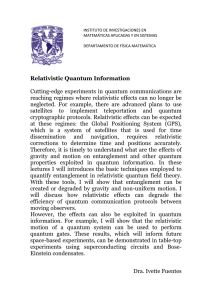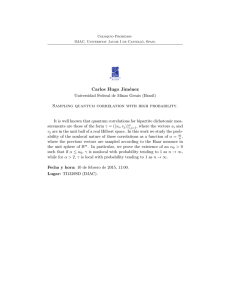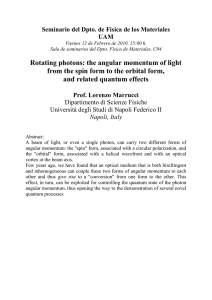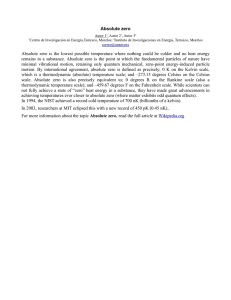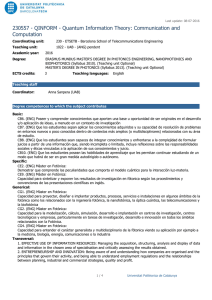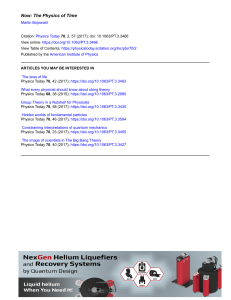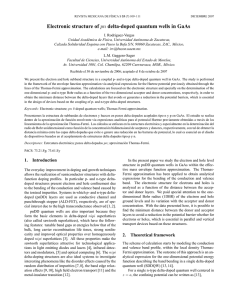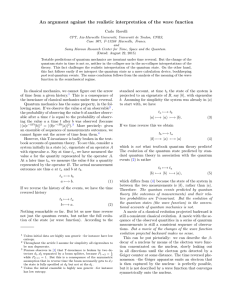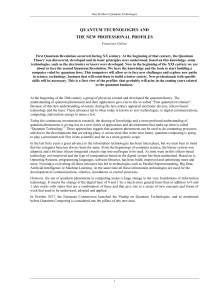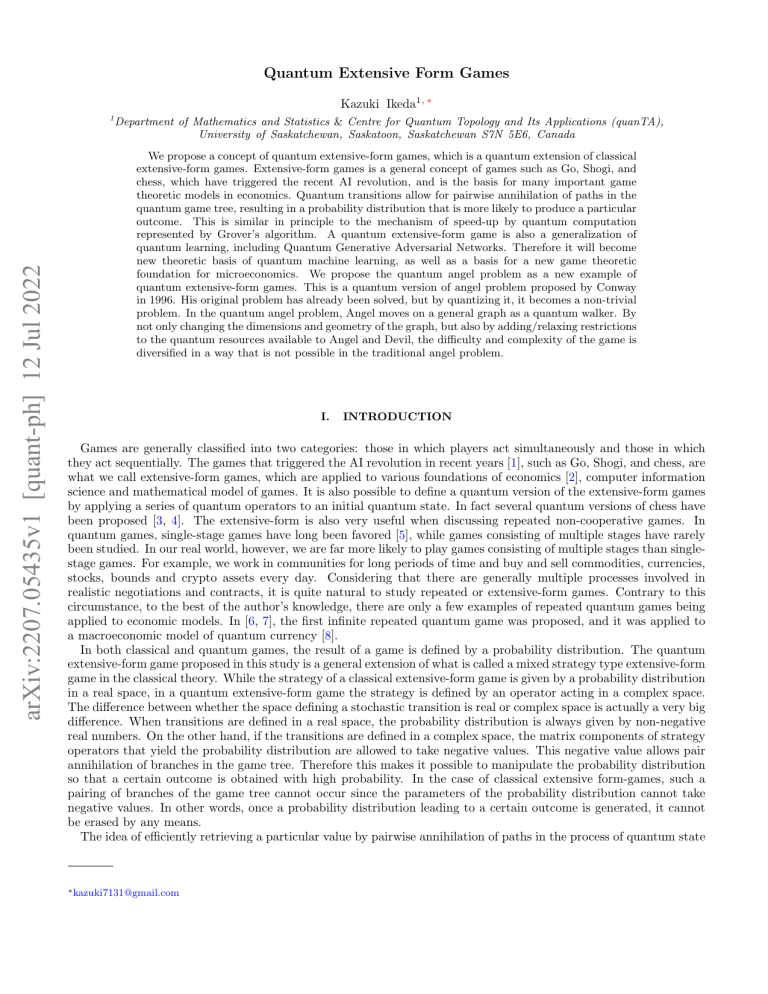
Quantum Extensive Form Games
Kazuki Ikeda1, ∗
arXiv:2207.05435v1 [quant-ph] 12 Jul 2022
1
Department of Mathematics and Statistics & Centre for Quantum Topology and Its Applications (quanTA),
University of Saskatchewan, Saskatoon, Saskatchewan S7N 5E6, Canada
We propose a concept of quantum extensive-form games, which is a quantum extension of classical
extensive-form games. Extensive-form games is a general concept of games such as Go, Shogi, and
chess, which have triggered the recent AI revolution, and is the basis for many important game
theoretic models in economics. Quantum transitions allow for pairwise annihilation of paths in the
quantum game tree, resulting in a probability distribution that is more likely to produce a particular
outcome. This is similar in principle to the mechanism of speed-up by quantum computation
represented by Grover’s algorithm. A quantum extensive-form game is also a generalization of
quantum learning, including Quantum Generative Adversarial Networks. Therefore it will become
new theoretic basis of quantum machine learning, as well as a basis for a new game theoretic
foundation for microeconomics. We propose the quantum angel problem as a new example of
quantum extensive-form games. This is a quantum version of angel problem proposed by Conway
in 1996. His original problem has already been solved, but by quantizing it, it becomes a non-trivial
problem. In the quantum angel problem, Angel moves on a general graph as a quantum walker. By
not only changing the dimensions and geometry of the graph, but also by adding/relaxing restrictions
to the quantum resources available to Angel and Devil, the difficulty and complexity of the game is
diversified in a way that is not possible in the traditional angel problem.
I.
INTRODUCTION
Games are generally classified into two categories: those in which players act simultaneously and those in which
they act sequentially. The games that triggered the AI revolution in recent years [1], such as Go, Shogi, and chess, are
what we call extensive-form games, which are applied to various foundations of economics [2], computer information
science and mathematical model of games. It is also possible to define a quantum version of the extensive-form games
by applying a series of quantum operators to an initial quantum state. In fact several quantum versions of chess have
been proposed [3, 4]. The extensive-form is also very useful when discussing repeated non-cooperative games. In
quantum games, single-stage games have long been favored [5], while games consisting of multiple stages have rarely
been studied. In our real world, however, we are far more likely to play games consisting of multiple stages than singlestage games. For example, we work in communities for long periods of time and buy and sell commodities, currencies,
stocks, bounds and crypto assets every day. Considering that there are generally multiple processes involved in
realistic negotiations and contracts, it is quite natural to study repeated or extensive-form games. Contrary to this
circumstance, to the best of the author’s knowledge, there are only a few examples of repeated quantum games being
applied to economic models. In [6, 7], the first infinite repeated quantum game was proposed, and it was applied to
a macroeconomic model of quantum currency [8].
In both classical and quantum games, the result of a game is defined by a probability distribution. The quantum
extensive-form game proposed in this study is a general extension of what is called a mixed strategy type extensive-form
game in the classical theory. While the strategy of a classical extensive-form game is given by a probability distribution
in a real space, in a quantum extensive-form game the strategy is defined by an operator acting in a complex space.
The difference between whether the space defining a stochastic transition is real or complex space is actually a very big
difference. When transitions are defined in a real space, the probability distribution is always given by non-negative
real numbers. On the other hand, if the transitions are defined in a complex space, the matrix components of strategy
operators that yield the probability distribution are allowed to take negative values. This negative value allows pair
annihilation of branches in the game tree. Therefore this makes it possible to manipulate the probability distribution
so that a certain outcome is obtained with high probability. In the case of classical extensive form-games, such a
pairing of branches of the game tree cannot occur since the parameters of the probability distribution cannot take
negative values. In other words, once a probability distribution leading to a certain outcome is generated, it cannot
be erased by any means.
The idea of efficiently retrieving a particular value by pairwise annihilation of paths in the process of quantum state
∗ kazuki7131@gmail.com
2
transformation is in fact the foundation of quantum algorithms. A typical example of an algorithm that achieves
such quantum acceleration is Grover’s algorithm, which solves the search problem of finding a specified value in an
unordered database of N elements [9]. In Grover’s algorithm, the initial state is given by a uniform superposition of
all values in the database. By repeatedly acting on this initial state with the two unitary operators U1 and U2 , the
value w to be searched for can be found efficiently, where U1 is the defined by an initial input state and U2 is defined
by w. The idea of acting U1 and U2 to the state many times in turn is the very essence of a quantum extensive-form
game.
Angel problem is a extensive-form game proposed by Conway in 1996 [10], where Angel and Devil take turns
playing on the checkerboard. This game has been solved by some ways [11–13]. In the traditional version, the status
of the game is a common knowledge for all players. Such games are called games with complete information. In this
paper, we quantize this game as follows. First, Angel moves on the graph as a quantum walker with power k. In
other words, Angel moves in a quantum manner to a point within a distance k from the point on the graph where it
is currently located. In addition, the game itself consists of incomplete information, since the entire transition of the
quantum state of Angel cannot be known.
By quantizing angel problem, the diversity of the game can be realized in a variety of ways, giving it a complexity
not found in the classical setting. Changing the topology or dimension of the graph defining the problem is one of
the most natural extensions. In fact, such extensions can be found in the classical version. The quantum version,
however, extends beyond mere geometric changes. The first case is when Angel and Devil have sufficient quantum
resources, i.e., when they can all implement any quantum operation and perform all possible observations that are
physically allowed. This setup may be the easiest to handle in obtaining analytical results for the game.
The second is when the quantum resources of Angel or (and) Devil are limited. This setup is most interesting
in implementing and playing games with real quantum computers. This is because all the quantum computers we
currently use are noisy and have a limitation in the shape of the graphs they can implement, so called NISQ devices [14].
Thanks to noise, however, Angel and Devil each have ample opportunity to win. In the traditional angel problem,
Angel has a winning strategy, but in the quantum version this is not always true and can be more exciting. In addition
to the presence of noise, another reason why the solution to this game could be non-trivial is that Angel is a quantum
walker with power k, whose behavior will be extremely hard to predict. Extending the quantum computing power
of Angel and Demon can also make the game more interesting. Computational theory based on theories beyond the
quantum theory of reality is of great importance to the field of computer science and has been the subject of much
research [15, 16].
Asking to what extent the quantum computational power of Angel and Devil can be limited or extended to make
the game more satisfactory for each would be a useful new question in mechanism design as well as the computational
complexity. For example, if the game can be designed so that Angel and Devil play the game enough times and each
has a 50% chance of winning, then it is fair game for both sides. While the conventional studies of quantum games
have so far focused on the strategic aspects not found in classical games, there has been little research on optimal
designs of game environments for players. In traditional game theory, designing optimal rules and games is practically
very important [17–19]. Looking at the quantum angel problem from a viewpoint of mechanism design, we can ask
the following question. Angel and Devil need to rent quantum computing resources from one company, and the fee
depends on the performance of the quantum computers available. They want to win the game as many as possible
and generate as much revenue as possible on a limited budget. Given the respective budgets of Angel and Devil, how
can we design the game so that their expected revenues can be fairly distributed? Such a general problem of optimal
allocation of quantum resources is likely to arise in the near future.
The main results of this paper and its contributions to quantum game theory can be summarized as follows.
• We gave a formal and rigorous formulation of quantum extensive-form games.
• We explained the importance of quantum quantum extensive-form games in relation to algorithms with quantum
advantage.
• We proposed the quantum angel problem as a new problem of computational complexity and mechanism design.
This paper is organized as follows. First, we will elaborate on the significance and motivation of quantum extensiveform games and establish a formal definition. Next, we formulate the quantum angel problem in concrete terms and
give the quantum operators to implement it. Finally, we describe the role of this research in the development of game
theory and suggest various future directions.
3
II.
FORMULATION QUANTUM EXTENSIVE-FORM GAMES AND QUANTUM ADVANTAGES
A.
Quantum Advantages in Repeated Games and Extensive Games
Extensive-form quantum games give very interesting results not found in classical games. To discuss why quantum
extensions of extensive form games and repeated games are effective, let us first discuss how quantum speedups of
computation can be achieved by quantum algorithms. We consider the simplest repeated game consisting of two
stages, as illustrated in the figure below.
FIG. 1: Transitions of states in classical and quantum game trees. Pair annihilation of branches can happen in a quantum
game tree.
The game is played by outputting 0 or 1, and some reward is given based on the result. Assuming the initial bit
is 0, we consider paths that move to 0 or 1 with a non-zero probability (a, · · · , f 6= 0). By the conservation law of
probability, the parameters a, · · · , f satisfy |a|2 + |b|2 = 1, |c|2 + |d|2 = 1 and |e|2 + |f |2 = 1, respectively. First, the
classical probabilities of obtaining 0 or 1 in the first step are |a|2 , |b|2 respectively:
Probclassical (0, t = 1) = |a|2 > 0
Probclassical (1, t = 1) = |b|2 > 0
(1)
The probability of moving to 0 or 1 after two steps is given by
Probclassical (0, t = 2) = A + C = |a|2 |c|2 + |b|2 |e|2 > 0
Probclassical (1, t = 2) = B + D = |a|2 |d|2 + |b|2 |f |2 > 0
(2)
It is obvious, unless a, · · · , f are zero, these probabilities will never be zero.
However, an interesting thing happens in the case of quantum stochastic transitions. To discuss this point, let us
consider the case where the unitary transition is given by the following matrices:
U1 = a|0ih0| + b|1ih0| + a0 |0ih1| + b0 |1ih1|
a a0
=
b b0
U2 = c|0ih0| + d|1ih0| + e|0ih1| + f |1ih1|
c e
=
.
d f
(3)
As before, we assume that the parameters a, · · · , f are non-zero. Since we are not interested in transitions from
|1i, a0 and b0 can be anything that satisfies the unitary condition. First, the probabilities of obtaining 0 or 1 in the
first step after applying U1 are
Probquantum (0, t = 1) = |a|2 > 0
Probquantum (1, t = 1) = |b|2 > 0
(4)
4
At this point, there is no difference from the case of the classic game. The probability of starting from state |0i
and transitioning to state |ki after two steps is generally given by the following formula
Probquantum (k, t = 2) = |hi|U2 U1 |0i|2 .
(5)
Therefore the probabilities of transitioning from to two steps later are
Probquantum (0, t = 2) = |A + C|2 = |ac + be|2 ≥ 0
Probquantum (1, t = 2) = |B + D|2 = |ad + bf |2 ≥ 0
(6)
What is strikingly different from the classical case is that even if the parameters are not zero, the probability of 0
being output after two steps can be zero if ac + be = 0. In this case, the probability of 1 being output is 1
Probquantum (0, t = 2) = 0 ⇔ Probquantum (1, t = 2) = 1.
(7)
One can check this by means of the unitary condition
U2 U2† = 1 ⇒ |c|2 + |e|2 = 1, cd∗ + ef ∗ = 0, |d|2 + |f |2 = 1.
(8)
The most important point is that such U2 always exists, regardless of the transition in the first step. The simplest
candidate for such U2 is U1† , which does exist since is unitary. The reason this cannot be achieved with classical
stochastic transitions is that the probability parameters of classical stochastic transitions are always positive and the
transitions are irreversible. On the other hand, quantum mechanical transitions are unitary and the parameters are
allowed to be negative, which essentially contributes to creating such a quantum advantage. Since complex numbers
can always be replaced by real numbers, it is more fundamental that negative numbers are allowed in the quantum
transition.
The operation of applying an operator two or more times U2 U1 |0i is truly an essence of repeated quantum games,
and by strategically adjusting the probability density distribution, it is possible to achieve an advantageous result that
would never be obtained in a classical game or a single-stage game. This also works well even for finitely repeated
quantum games. This is in contrast to the classical repeated games, where a finite number of iterations can be
considered equivalent to a single-stage game.
To make the above more game-theoretic, let gi (k) be the reward for Player i when outcome k ∈ {0, 1} is obtained.
The player applies sequentially unitary operators U1 , · · · , Uk to the initial state |0i. The expected profit when the
state |0i is observed at time t is given by
X
gi t, {Uτ }tτ =1 =
gi (k)|hi|Ut Ut−1 · · · U1 |0i|2 .
(9)
k∈{0,1}
The discussion and observations in this section can be summarized as follows.
• Certain probability distributions can appear or disappear with high probability due to the pairwise annihilation
of certain paths.
• In the case of quantum games, a finitely repeated game is not equivalent to a single-stage game. Finite repetitions
can also produce superior results that cannot be obtained in a single-stage game.
• These ideas are valid not only for repeated games, but also for games with several different stages and extensiveform games. For example, some effective results showing quantum advantages in a game theory of contracts
were first reported in [20] for quantum principal-agent problems, adverse selections and moral hazard problems.
B.
Quantum Game Tree and Strategy
Now let us give a formal definition of quantum extensive-form games.
Definition II.1. An quantum extensive-form game is defined by a tuple ΓQ = (N, K, P, I, g) consisting of the
following date:
• N = {1, · · · , n}: A set of n players.
5
• A quantum game tree K with a set of quantum states of nodes V , a initial quantum state of node v0 ∈ V . Each
node can be classified into either a vertex or a move: V = X ∪ W, X ∩ W = ∅, where X is the set of all moves
and W is the set of all vertexes.
Sn
• Player partition P = {P1 , · · · , Pn } that assigns each player to a set of moves: X = i=1 Pi , Pi ∩ Pj = ∅ for all
i, j and Pi 6= ∅.
S
• Information partition I = {I1 , · · · , In }. Each Ii is a family of subsets of Pi , which is written as Pi = u∈Ii u.
Elements of Ii satisfy u ∩ v = ∅ for all u, v ∈ Pi such that u 6= v.
• Payoff function g(w) = (g1 (w), · · · , gn (w)), |wi ∈ W of all players.
A quantum game is called a quantum game with complete information when everyone knows the game and everyone
is aware of it, otherwise it is a quantum game with incomplete information. In many cases, quantum extensive form
games consists of imperfect information, since the quantum states that make up the game cannot be known exactly.
Let B(|ψi) be the set of quantum moves connected by alternatives from |ψi. In other words, B(|ψi) is the set of
points immediately after a quantum move |ψi. We define the set of quantum moves from u ∈ Ii by
[
B(u) =
B(|ψi).
(10)
|ψi∈u
In a classical extensive form game, a classical move x and each point of B(x) are connected by a branch called
alternative. The set of such alternatives is described as A(x) and A(u) = ∪x∈u A(x) is the set of alternatives in the
information set u ∈ Ii . A strategy in a classical extensive form game is given by a map from u ∈ Ii to A(u). In the
quantum extensive form games, a strategy is a map from a quantum state to quantum state.
Definition II.2. A quantum strategy of Player i is a quantum channel Λ from u ∈ Ii to B(u).
A map Λ that transfers a quantum state |ψi in a Hilbert space H to another quantum state |ψ 0 i = Λ(|ψi) is called
a quantum channel. The Hilbert space to which the quantum state |ψi is mapped may be different from the original
space H. It can be the same Hilbert space if all players are playing the game on the same platform, or a different
Hilbert space if they are using different platforms. For example, a quantum crypto key is defined as a map from a
high-dimensional Hilbert space to a low-dimensional Hilbert space.
Let us illustrate the structure of a quantum extensive-form game using the example in Fig.2. In this game two
players take turns playing.
FIG. 2: Quantum game tree of an quantum extensive-form game.
6
In this setup, the player partitions are
P1 = {|ψ11 i , · · · , |ψ51 i}
(11)
2
P2 = {|ψ12 i , · · · , |ψ10
i}.
Information partitions could be
I1 = {{|ψ11 i}, {|ψ21 i, |ψ51 i}, {|ψ31 i, |ψ41 i}}
(12)
2
I2 = {{|ψ12 i , |ψ22 i}, {|ψ32 i, · · · , |ψ62 i}, {|ψ72 i, · · · , |ψ10
i}}.
There can be many other ways to choose information partitions. As long as they satisfy Pi =
for all u, v ∈ Pi such that u 6= v.
For example, the sets of quantum moves connected by alternatives from |ψ11 i and |ψ12 i are
B(|ψ11 i) = {|ψ12 i , |ψ22 i}
B(|ψ12 i) = {|ψ21 i , |ψ31 i}.
S
u∈Ii
u and u ∩ v = ∅
(13)
Therefore when u = {|ψ12 i , |ψ22 i} ∈ I2 , then the corresponding set B(u) of quantum moves is
B(u) = {|ψ21 i , |ψ31 i , |ψ41 i , |ψ51 i}.
(14)
Given the sets of quantum moves u and B(u) in this way, a quantum strategy of Player 2 is a quantum channel from
u to B(u). The Hilbert space in which u is defined and the Hilbert space in which B(u) is defined may be different
in general. This transfers Player 2’s turn to Player 1, who then considers a new quantum strategy.
C.
Relation to Former Works
In order to most clearly convey the significance of the quantum extensive-form game proposed in this study, we
first compare it with Grover’s algorithm [9], which is a well-known quantum algorithm showing quantum speedup.
The goal of this algorithm is to efficiently find the desired information w from a database consisting of N data points.
The initial state is the uniform superposition of all data
N −1
1 X
|ii .
|ψin i = √
N i=0
(15)
The quantum operator U2 U1 is repeatedly acted on this initial state, where
U1 = 2 |ψin i hψin | − I
U2 = I − 2 |wi hw| .
(16)
(17)
It is truly an extensive-form game in the sense that U1 and U2 are applied multiple times in turn, and transitions
of the initial quantum state can√also be described using a game tree. w can be found by iteratively applying the
Grover iteration U2 U1 about O( N ) times, which is known to take O(N ) times in the classical best way. This is
made possible by efficiently eliminating branches in which anything other than w appears.
An important example of quantum extensive-form games is quantum generative adversarial learning (GAN) [21, 22],
which increases the accuracy of data learning by allowing two neural networks to compete with each other. The
most obvious example would be the emergence of quantum GANs for playing quantum chess, but of course, the
applications are not limited to such simple examples. Even classical GANs are used everywhere, including image
and video generation, and it is not difficult to foresee that in the future quantum GANs will play an equally or even
more important role than current classical GANs. Any such quantum GAN can always be expressed in a quantum
extensive-form.
Although it has not been given much importance in the past, quantum extensive-form games are a new way of
thinking that can handle several important examples like this in a general way. By establishing a formal theory
of quantum extensive-form games, it will be possible to conduct research on quantum algorithms from a bird’s-eye,
multifaceted, and unified perspective.
7
III.
QUANTUM ANGEL PROBLEM
A.
Overview
As an example of quantum extensive-form games, let us create a quantum version of Angel Game. The classical
Angel Game was invented by Conway in 1996 [10] and investigated by many authors [11–13]. The quantum angel
problem is played by two players called Angel and Devil. Angel is a quantum walker on a given graph G and move on
the graph within the range allowed by the predetermined power k. Devil can add blocks to one vertex of the graph
where there is no Angel. It is easy to extend this game so that Devil puts blocks (quantum) statistically.
The rules are basically the same as before, except that Angel is a quantum walker. Angel and Devil take turns
playing their respective strategies. Devil wins if Angel is unable to move, and Angel wins if she can keep running
from Devil’s pursuit. Angel can tunnel the blocks, but cannot be in the same position as the blocks, in accordance
with Pauli’s exclusionary rule.
• Angel can move to any place within a distance k where no blocks are placed.
• Devil can place a block if no Angel is detected at the location where they want to place the block.
B.
Quantum Angel with Power k
Here we formulate the general behavior of Angel with power k. For this, we first introduce a quantum walker that
can move to a point within a range of at most k. The position of Angel is described by a Hilbert space HP spanned
by integer values on the lattice {|ii , i ∈ Z}. Quantum walkers that can travel up to distance k in one time step do
not seem to have been studied much. This is because such quantum walkers can travel beyond the speed of light,
violating the relativistic law of causality. So far, most quantum walk studies are designed not to break the laws of
physics. However, in considering the game, any quantum walker is feasible as long as it is programmable.
In this paper, for the sake of brevity and concreteness, the discussion will be limited to a one-dimensional lattice,
but it can be extended to arbitrary graphs in any dimension, which would be a meaningful question. The most general
form of Angel’s state at t = n is given below:
|Ψn (x)i =
k
X
ψnm (x) |mi ,
m=−k
k
X
|ψnm (x)|2 = 1
(18)
m=−k
where x ∈ Z indicates the position of Angel on a 1D lattice. The probability measure of Angel at time t = n at
location x is defined by
k
X
µn (x) =
|ψnm (x)|2 .
(19)
m=−k
The transition operator which maps Angel to |mi is given by
Um =
k
X
alm |mi hl| ,
(20)
l=−k
where the condition of the matrix a = (alm ) is determined by the unitarity of U
U=
k
X
Um , U † U = 1.
(21)
m=−k
It should be noticed that each operator does not commute in general, which allows Angel to have more strategic
options.
For example, the k = 1 case corresponds to the three-state quantum walk. In the most widely studied quantum
walk, a walker can only travel to an adjacent point in one step, but in the quantum Angel game, Angel can travel
anywhere within a distance k. Therefore the transition equation of Angel is
|Ψn+1 (x)i =
x+k
X
y=x−k
Ux−y |Ψn (y)i , x, y ∈ Z.
(22)
8
U−3
U3
U0
U−2
x−3
x−2
U2
x
x−1
U−1
x+1
x+2
x+3
U1
FIG. 3: Hopping of a quantum walker with power k.
We put the initial state as |Ψ0 (0)i = T [a−k , · · · , ak ] satisfying
k
X
|al |2 = 1.
l=−k
The general state of Angel at t = n is given by
Ψ(t = n) = T [· · · , |Ψn (−1)i , |Ψn (0)i , |Ψn (1)i , · · · ].
(23)
Let us give an alternative definition of Angel living in Hp ⊗ Hk , where l2 (Z) is the position space and Hk is the
space of Angel’s power. The transition operator of Angel with power k is
X
Sm =
|x + mi hx| , m = −k, · · · , k.
(24)
x∈Z
The dynamics of Angel is defined as follows
Ut =
k
X
!
Sm ⊗ Um
(I∞ ⊗ U (t)),
(25)
m=−k
where I∞ is the identity operator and U (t) is a strategy of Angel at time t. Then a general state of Angel after n
time steps is given as
!
n
O
Ψ(t = n) =
Ut Ψ(t = 0).
(26)
t=1
C.
Quantum Angel v.s. Devil
Let us now discuss variants of the quantum angel problem. As already mentioned several times, the main reasons
why the quantum angel problem differs from the traditional angel problem are that 1) Angel is a quantum walker
and 2) it is possible to impose limits on the quantum resources available to Angel and Devil.
The first point that Angel is a quantum walker gives good reason why this game could be interesting even if it is
one-dimensional. As is already widely known, the probability distribution of a one-dimensional quantum walk is quite
different from that of a classical random walk [23–25]. Especially in the case of the Hadamard walk, the probability
distribution of the quantum walker spreads left and right at the speed of light. This means that it will be extremely
difficult for Devil to predict Angel’s location. These are all for Angel with power k = 1, i.e., when Angel can only
move to adjacent sites in one time step, but it would be even more difficult to predict the quantum walker’s location
when k is 3 or greater, as we formulate in this paper. Our method can be easily extended to quantum walks on
general graphs [26].
Regarding the second point, there are actually a number of interesting variations. From the practical point of
view of currently available quantum computers, games using non-universal quantum computers are very interesting.
Research on quantum computers, which are not universal but are more powerful than classical computers, is very
useful and important today [27–29]. They are the most important class of problems, not only in the study of the
polynomial hierarchy of computational complexity, but also for potential applications of NISQ devices. Depending on
the quantum resources available to Angel and Devil, the game is divided into the following nine cases (Table I).
9
1 .
• Both Angel and Devil can use unlimited quantum resources ○
6 .
3 ,○
2 ,○
• Angel can use better quantum resources than Devil ○
8 .
7 ,○
4 ,○
• Devil can use better quantum resources than Angel ○
5 .
• Both Angel and Devil can use non-universal quantum computers ○
9 .
• Both Angel and Devil can only perform classical calculations ○
It is interesting to ask whether Angel or Devil have the advantage or the winning strategy in these nine cases.
These are new questions that have not been asked in the traditional angel problem. In the classical case, Angel has
no chance of winning against Devil in one dimension. So if Angel capable of universal quantum computation has a
high probability of beating Devil, then by properly limiting the resources of Devil and Angel, it is always possible to
create an environment in which both have a 50% chance of winning.
So far we have considered limiting the ability of players, but we can also extend it. Studying the behavior of
players with computational capabilities beyond quantum theory is also useful in understanding the upper bounds of
quantum computation. Indeed, a number of such classes of theories have been investigated in the field of quantum
computation [15, 16]. For example, if Angel is capable of post-selection, the desired result can be obtained with
probability 1, in a way that there is no probability fluctuation. It would be an interesting question of mechanism
design to investigate how much to limit or extend the computational power of Angel and Devil to make a good game.
Angel \ Devil
Universal Quantum Non-Universal Classical
1
○
4
○
7
○
Universal Quantum
Non-Universal
Classical
2
○
5
○
8
○
3
○
6
○
9
○
TABLE I: Classification of quantum angel problem based on quantum resources available to Angel and Devil.
IV.
QUANTUM CIRCUIT OF QUANTUM ANGEL PROBLEM
A.
Operators of Devil
Here we create operators of Devil for placing a block at x. For this Devil needs to prepare two operators: creating
a block and diagnosing Angel’s occupancy. The second operation is needed since Devil is allowed to place a block if
Angel is not detected there. We first explain how to create the operator to create a block.
We denote the states without and with blocks by |0i and |1i, respectively. In general, the block’s state at x can be
a superposition
|ψx i = αx |0i + βx |1i
(27)
and the state of all blocks looks like
|ψi =
T
α−1
α0
α+1
··· ,
,
,
,··· .
β−1
β0
β+1
(28)
Devil can place a block at x by using the following operators. Devil first adds |0i to each |ψx i and operates |0i h0| ⊗
I + |1i h1| ⊗ X to |ψx i |0i. By operating X ⊗ |0i h0| + I ⊗ |1i h1| to it again and measuring the second qubit, Devil can
obtain |1i with probability 1. This procedure is summarized in the following diagram and circuit (Fig.4)
CNOT
CNOT
Measurement
(αx |0i + βx |1i) |0i −−−−→ αx |0i |0i + βx |1i |1i −−−−→ αx |1i |0i + βx |1i |1i −−−−−−−−→ |1i
|ψx i
|1i
|0i
FIG. 4: Creating a block at x.
(29)
10
Before placing a block, Devil needs to know whether or not Angel is present at that location. For this, Devil adds
a qubit on each x and denotes |1i if there is Angel at x and |0i if there is not, respectively. Then whether Angel is at
x or not can generally be expressed in the following state.
|ϕx i = ax |0i + bx |1i ,
(30)
which should be normalized |ax |2 + |bx |2 = 1. In general Devil can diagnose the presence of Angel by the following
state
a−1
a0
a+1
|ϕi = T · · · ,
,
,
,··· .
(31)
b−1
b0
b+1
Then Devil adds another |0i to each |ϕx i and applies the CNOT operation
CNOT
(ax |0i + bx |1i) |0i −−−−→ ax |0i |0i + bx |1i |1i
(32)
If the measurement result of the second qubit is 0, we say that Angel is not at x. If it is 1, we say that Angel is there.
Clearly one can get |0i and |1i with probability |ax |2 and |bx |2 , respectively. The circuit of this operation is drawn in
Fig.5
|ϕx i
|0i
FIG. 5: Diagnosing Angel’s presence at x.
B.
Operations of Angel
Here we define the operator to determine where Angel can move. It must be consistent with the rules of the game
that Angel cannot move to a point where a block is placed. Recall that the block’s state at x is represented by
|ψx i = αx |0i + βx |1i ,
(33)
Angel can know if there is a block there by applying the CNOT operation.
CNOT
(αx |0i + βx |1i) |0i −−−−→ αx |0i |0i + βx |1i |1i
(34)
By measuring the second qubit, Angel finds a block with probability |βx |2 .
V.
CONCLUSION AND FUTURE DIRECTIONS
In this study, we formulated the concept of quantum extensive-form games mathematically. We also confirmed
that several important quantum algorithms, such as the Grover algorithm and quantum GAN, can be expressed in
quantum extensive form. Given that a number of important models in game theory are described in extensive forms,
it is surprising that quantum extensive-form games have received so little attention. Until now, an excessive amount
of attention has been paid to the EWL protocol in quantum games (single stage games in most cases), but we hope
that this research will be one of the catalysts for turning attention to the study of quantum extensive-form games.
Any number of research topics could follow this paper. Pursuing Nash equilibrium solutions of quantum extensiveform games is a natural and important mathematical topic, and contributes significantly to the development of
models in economics. It would also be very meaningful to discuss existing concrete non-cooperative quantum games
in a quantum extensive form in order to discuss repeated games. In existing quantum games, single-stage games
have been studied extensively, while the importance of repeated games has not been recognized. As mentioned many
times in this paper, in order to take full advantage of quantum nature in game theory, it is wiser to use the pairwise
annihilation of branches which occurs through quantum mechanical transitions of states, rather than considering
entanglement alone. The excessive focus on entanglement in the existing quantum game does not necessarily match
11
the study of algorithms that enable quantum advantage. In fact, it is known that universal quantum computation
can be achieved with only a small amount of entanglement [30]. This could the background to the fact that existing
quantum games have yielded few useful results, but as this study has shown, the situation could be improved by
considering quantum extensive-form games.
Regarding the quantum Angel game, a number of interesting studies would be possible. First, it would be intriguing
to examine to which class of the polynomial hierarchy the nine cases of games presented in Table 1 belong, and whether
Angel or Devil are favored in each case. Besides, it would be fun to actually implement and play this game on a NISQ
device.
Acknowledgement
The author is supported by PIMS Postdoctoral Fellowship Award. The author thanks Dmitri Kharzeev and Steven
Rayan for useful discussion, collaborations and encouragement.
[1] D. Silver, A. Huang, C. J. Maddison, A. Guez, L. Sifre, G. Van Den Driessche, J. Schrittwieser, I. Antonoglou,
V. Panneershelvam, M. Lanctot, et al., “Mastering the game of go with deep neural networks and tree search,” nature
529 no. 7587, (2016) 484–489.
[2] S. Hart, “Games in extensive and strategic forms,” Handbook of game theory with economic applications 1 (1992) 19–40.
[3] S. G. AKL, “On the importance of being quantum,” Parallel Processing Letters 20 no. 03, (2010) 275–286,
https://doi.org/10.1142/S0129626410000223. https://doi.org/10.1142/S0129626410000223.
[4] C. Cantwell, “Quantum chess: Developing a mathematical framework and design methodology for creating quantum
games,” arXiv preprint arXiv:1906.05836 (2019) .
[5] J. Eisert, M. Wilkens, and M. Lewenstein, “Quantum Games and Quantum Strategies,” Physical Review Letters 83
no. 15, (Oct., 1999) 3077–3080, arXiv:quant-ph/9806088 [quant-ph].
[6] K. Ikeda, “Foundation of quantum optimal transport and applications,” Quantum Information Processing 19 no. 1,
(Nov., 2019) 25. https://doi.org/10.1007/s11128-019-2519-8.
[7] K. Ikeda and S. Aoki, “Theory of quantum games and quantum economic behavior,” Quantum Information Processing
21 no. 1, (Dec., 2021) 27. https://doi.org/10.1007/s11128-021-03378-5.
[8] K. Ikeda and S. Aoki, “Infinitely repeated quantum games and strategic efficiency,” Quantum Information Processing 20
no. 12, (Dec., 2021) 387, arXiv:2005.05588 [quant-ph].
[9] L. K. Grover, “A framework for fast quantum mechanical algorithms,” in Proceedings of the thirtieth annual ACM
symposium on Theory of computing, pp. 53–62. 1998.
[10] J. H. Conway, “The angel problem,” Games of no chance 29 (1996) 3–12.
[11] A. Máthé, “The angel of power 2 wins,” Combinatorics, Probability and Computing 16 no. 3, (2007) 363–374.
[12] B. H. Bowditch, “The angel game in the plane,” Combinatorics, Probability and Computing 16 no. 3, (2007) 345–362.
[13] O. Kloster, “A solution to the angel problem,” Theoretical Computer Science 389 no. 1-2, (2007) 152–161.
[14] J. Preskill, “Quantum Computing in the NISQ era and beyond,” arXiv e-prints (Jan., 2018) arXiv:1801.00862,
arXiv:1801.00862 [quant-ph].
[15] S. Aaronson, “Is Quantum Mechanics An Island In Theoryspace?,” arXiv e-prints (Jan., 2004) quant–ph/0401062,
arXiv:quant-ph/0401062 [quant-ph].
[16] S. Aaronson and J. Watrous, “Closed timelike curves make quantum and classical computing equivalent,” Proceedings of
the Royal Society A: Mathematical, Physical and Engineering Sciences 465 no. 2102, (2009) 631–647.
[17] L. Hurwicz, “The design of mechanisms for resource allocation,” The American Economic Review 63 no. 2, (1973) 1–30.
http://www.jstor.org/stable/1817047.
[18] E. Maskin, “Nash equilibrium and welfare optimality,” The Review of Economic Studies 66 no. 1, (1999) 23–38.
http://www.jstor.org/stable/2566947.
[19] R. B. Myerson, “Optimal auction design,” Mathematics of Operations Research 6 no. 1, (1981) 58–73,
https://doi.org/10.1287/moor.6.1.58. https://doi.org/10.1287/moor.6.1.58.
[20] K. Ikeda, “Quantum contracts between schrödinger and a cat,” Quantum Information Processing 20 no. 9, (2021) 1–25.
https://doi.org/10.1007/s11128-021-03252-4.
[21] S. Lloyd and C. Weedbrook, “Quantum generative adversarial learning,” Phys. Rev. Lett. 121 (Jul, 2018) 040502.
https://link.aps.org/doi/10.1103/PhysRevLett.121.040502.
[22] C. Zoufal, A. Lucchi, and S. Woerner, “Quantum generative adversarial networks for learning and loading random
distributions,” npj Quantum Information 5 no. 1, (2019) 1–9.
[23] A. Ambainis, E. Bach, A. Nayak, A. Vishwanath, and J. Watrous, “One-dimensional quantum walks,” STOC ’01,
p. 37–49. Association for Computing Machinery, New York, NY, USA, 2001. https://doi.org/10.1145/380752.380757.
[24] A. M. Childs, E. Farhi, and S. Gutmann, “An example of the difference between quantum and classical random walks,”
arXiv e-prints (Mar., 2001) quant–ph/0103020, arXiv:quant-ph/0103020 [quant-ph].
12
[25] N. Konno, “Quantum random walks in one dimension,” Quantum Information Processing 1 no. 5, (2002) 345–354.
[26] D. Aharonov, A. Ambainis, J. Kempe, and U. Vazirani, “Quantum Walks On Graphs,” arXiv e-prints (Dec., 2000)
quant–ph/0012090, arXiv:quant-ph/0012090 [quant-ph].
[27] B. M. Terhal and D. P. Divincenzo, “Classical simulation of noninteracting-fermion quantum circuits,” Phys. Rev. A 65
no. 3, (Mar., 2002) 032325, arXiv:quant-ph/0108010 [quant-ph].
[28] M. J. Bremner, R. Jozsa, and D. J. Shepherd, “Classical simulation of commuting quantum computations implies
collapse of the polynomial hierarchy,” Proceedings of the Royal Society A: Mathematical, Physical and Engineering
Sciences 467 no. 2126, (2011) 459–472, https://royalsocietypublishing.org/doi/pdf/10.1098/rspa.2010.0301.
https://royalsocietypublishing.org/doi/abs/10.1098/rspa.2010.0301.
[29] E. Knill and R. Laflamme, “Power of one bit of quantum information,” Phys. Rev. Lett. 81 (Dec, 1998) 5672–5675.
https://link.aps.org/doi/10.1103/PhysRevLett.81.5672.
[30] M. Van den Nest, “Universal quantum computation with little entanglement,” Phys. Rev. Lett. 110 (Feb, 2013) 060504.
https://link.aps.org/doi/10.1103/PhysRevLett.110.060504.
